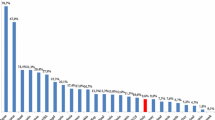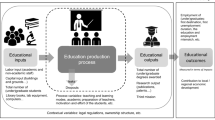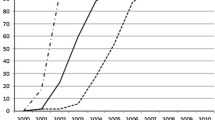Abstract
The growing internationalization of European Higher Education requires more emphasis on cross-country comparisons. In this paper, an efficiency analysis of Italian and Spanish universities is conducted; as well as from a comparative perspective. The efficiency scores are obtained using data envelopment analysis. The results demonstrate a good average efficiency in both countries relative to each “country-specific” frontier; but when compared together, Italian universities seem relatively more efficient. Malmquist indexes show, in both cases, efficiency improvements in the period considered. In the Italian case, this improvement is due to major “technological changes”; that is, the introduction of some structural reforms in the sector (e.g., Bachelor/Master curricula). In the Spanish case, there is an improvement in “pure” efficiency, which is due to new funding models. Further stages of the study underline the role of “regional effects”, probably due to different socio-economic conditions in Italy, and to the decentralization process in Spain.



Similar content being viewed by others
Notes
Rankings could appear as a mechanism to assess the “quality of Higher Education”, a concept that, far from being clear, leads to certain misunderstandings in its measure, in particular due to the abstract use of the term. Quality is not a one-dimensional but rather a multidimensional concept: quality of teaching, quality of research, quality as a combination of activities, institutional mission, etc. The league tables do not provide a complete picture of the sector.
The comparison was made referring exclusively to EU-15 States; we decided to not to include the accession states.
Indeed, for these two countries the proper definition is “University System” for referring to tertiary-level education.
The authors are aware that this interpretation is misleading, because differences are due mainly to differences in types and levels of activities provided by HE institutions—but the aim of this comparison is to have a look at differences in general levels of funding.
As stated above, the “production process” in which universities are involved is actually too complicated to be described, as it is a “multi-function” process. However, a graphical illustration of the simplified production process assumed in this paper is provided in Fig. 2.
In both countries, these data are collected on a cash-basis, so the accounting standards are quite similar and the financial indicators adopted here are comparable.
However, this problem is mitigated by the fact that only efficiency scores vary, while rankings generated in VRS elaborations are not affected by the choice of input/output orientation.
The only exception to this rule is for Italian data of academic year 2000/2001, which are matched with financial year 2001, since there are no comparable data for the financial year 2000—however, looking at the main dimensions of these data, there are no substantive differences which can affect the main results.
The Italian universities not included in the sample are Napoli Parthenope because it has some missing data and “Perugia per stranieri” and “Siena per stranieri”, as they are focused only on education for foreign students (and they are very small universities indeed). The Spanish universities not included in the sample are: Universidad Politécnica de Cartagena, since it was established only few years ago (it is “too recent”), UNED (Universidad Nacional de Educación a Distancia), which provides only distance learning, UIMP (Universidad Internacional Menéndez Pelayo) and Universidad Internacional de Andalucia because they only provide summer schools (no traditional courses).
All the elaborations are made using the software DEAExcelSolver© provided by Zhu (2003).
The results obtained for Italy are coherent with previous studies on the efficiency of Italian universities. More specifically, the correlation with the results reported by Agasisti and Dal Bianco (2006) is about 0.5; since the variables utilized and the reference years are different, it is a good correlation. On the other hand, the correlations are very low between the results provided in this paper and those by Agasisti and Johnes (2006). The incoherence in these results is reasonably attributable to two reasons. First, they computed efficiency estimating a cost function, using a different approach in the selection of variables. Furthermore, they adopted a different methodology, the random parameter model, which is a parametric technique; the difficulty in comparing results derived from different sources is well-known (e.g., McMillan and Chan 2006), and future research will address this point specifically. For the same reasons, the results obtained for Spanish universities presented here differ considerably from those of Johnes and Salas-Velasco (2007). Moreover, they also used a restricted sample of Spanish universities, implying a further difficulty in comparing these results.
These universities are part of different regional university systems within Spain, and their features and degree of consolidation also differ. Moreover, they belong to different regions in terms of wealth: e.g., UAB is in Catalonia (a very rich Spanish region), while UEX is in Extremadura (which is very poor).
For reasons of space, the detailed results on the efficiency analyses in 2000/2001 are not reported here, but they are available on request from the authors.
The seven regions that could have “faster” responsibilities (in education, health, etc.) at that time were defined by the Spanish Constitution of 1978, which are: Andalucía, Canarias, Catalonia, Comunidad Valenciana, Galicia, Navarra, and País Vasco. The other ten Spanish regions reached the same level of autonomy, according to those responsibilities, later in time.
References
Abbott, M., & Doucouliagos, C. (2003). The efficiency of Australian universities: A data envelopment analysis. Economics of Education Review, 22(1), 89–97. doi:10.1016/S0272-7757(01)00068-1.
Agasisti, T., & Dal Bianco, A. (2006). Data envelopment analysis to the Italian University system: Theoretical issues and policy implications. International Journal of Business Performance Management, 8(4), 344–367. doi:10.1504/IJBPM.2006.009613.
Agasisti, T., & Johnes, G. (2006). Heterogeneity and the evaluation of efficiency: The case of Italian universities. Lancaster University Management School (mimeo).
Agasisti, T., & Johnes, G. (2009). Beyond frontiers: Comparing the efficiency of higher education decision-making units across countries. Education Economics, 17(1), 59–79.
Athanassopoulos, A. D., & Shale, E. (1997). Assessing the comparative efficiency of higher education institutions in the UK by means of data envelopment analysis. Education Economics, v5(2), 117–134.
Bonaccorsi, A., & Daraio, C. (2007). Universities and strategic knowledge creation. Specialization and performance in Europe. Cheltenham, UK and Northampton, MA: Edward Elgar.
Carrington, R., Coelli, T., & Rao, P. (2005). Measuring the performance of Australian universities: Conceptual issues and initial results. Economic Papers, 24(2), 145–163.
Caves, D. W., Christensen, L. R., & Diewert, W. E. (1982). Multilateral comparisons of output, input, and productivity using superlative index numbers. The Economic Journal, 92(365), 73–86. doi:10.2307/2232257.
Cohn, E., Rhine, S., & Santos, M. (1989). Institutions of higher education as multi-product firms: Economies of scale and scope. The Review of Economics and Statistics, 71(2), 284–290. doi:10.2307/1926974.
Cooper, W. W., Seiford, L. M., & Tone, K. (2006). Introduction to data envelopment analysis and its uses. New York: Springer.
CRUE. (2006). La Universidad Española en Cifras. Madrid: CRUE.
EU—European Commission. (2006). Efficiency and equity in European education and training systems. COM (2006) 481 final.
Johnes, J. (2004). Efficiency measurement. In G. Johnes & J. Johnes (Eds.), International handbook on the economics of education. Cheltenham: Edward Elgar Publishing Ltd.
Johnes, G. (2006a). Education and economic growth. Lancaster University Management School. Working paper no. 2006/019.
Johnes, J. (2006b). Data envelopment analysis and its application to the measurement of efficiency in higher education. Economics of Education Review, 25(3), 273–288. doi:10.1016/j.econedurev.2005.02.005.
Johnes, G., & Johnes, J. (1995). Research funding and performance in U.K. Departments of Economics: A frontier analysis. Economics of Education Review, 14(3), 301–314. doi:10.1016/0272-7757(95)00008-8.
Johnes, G., & Salas-Velasco, M. (2007). The determinants of costs and efficiencies where producers are heterogeneous: The case of Spanish universities. Economic Bulletin, 4(15), 1–9.
Joumady, O., & Ris, C. (2005). Performance in European higher education: A non-parametric production frontier approach. Education Economics, 13(2), 189–205. doi:10.1080/09645290500031215.
Malmquist, S. (1953). Index numbers and indifference surfaces. Trabajos de Esdatistica, 4(1), 209–242. doi:10.1007/BF03006863.
Martínez Cabrera, M. (2000). Análisis de la Eficiencia Productiva de las Instituciones de Educación Superior. Papeles de Economía Española, (86), 179–191.
McMillan, M. L., & Chan, W. H. (2006). University efficiency: A comparison and consolidation of results from stochastic and non stochastic methods. Education Economics, 14(1), 1–30. doi:10.1080/09645290500481857.
McMillan, M. L., & Datta, D. (1998). The relative efficiencies of Canadian universities: A DEA perspective. Canadian Public Policy, 24(4), 485–511. doi:10.2307/3552021.
OECD. (2006a). Education policy analysis: Focus on higher education. Paris: OECD.
OECD. (2006b). Education at a glance 2006. Paris: OECD.
OECD. (2007). Education at a glance 2007. Paris: OECD.
Pérez-Esparrells, C. (2004). La Educación Universitaria en España: El Vínculo entre Financiación y Calidad. Revista de Educación (Ministerio de Educación y Ciencia), Septiembre–Diciembre(335), 305–316.
Warning, S. (2004). Performance differences in German higher education: Empirical analysis of strategic groups. Review of Industrial Organization, 24(4), 393–408. doi:10.1023/B:REIO.0000037538.48594.2c.
Zhu, J. (2003). Quantitative models for performance evaluation and benchmarking. Boston, MA: Kluwer.
Acknowledgments
We are grateful to M. Abbott, A. Dal Bianco, G. Catalano, B. Jongbloed, G. Johnes, M. McMillan, J. G. Mora and C. Salerno, who provided useful comments on earlier drafts of this paper. Comments by anonymous referees also helped in improving the paper. Obviously, all eventual errors are our own.
Author information
Authors and Affiliations
Corresponding author
Additional information
An earlier version of this work has been published previously as a Working Paper N. 369/2008 in “Colección de Documentos de Trabajo de la Fundación de las Cajas de Ahorros (FUNCAS)”.
Rights and permissions
About this article
Cite this article
Agasisti, T., Pérez-Esparrells, C. Comparing efficiency in a cross-country perspective: the case of Italian and Spanish state universities. High Educ 59, 85–103 (2010). https://doi.org/10.1007/s10734-009-9235-8
Received:
Accepted:
Published:
Issue Date:
DOI: https://doi.org/10.1007/s10734-009-9235-8




